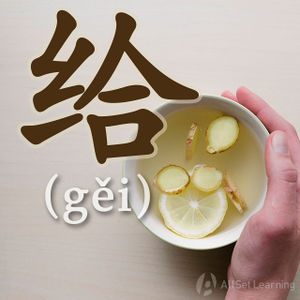Difference between revisions of "Expressing "for" with "gei""
| Line 3: | Line 3: | ||
The preposition 给 (gěi) can mean for "for," as in, "everything I do, I do it ''for'' you." In this case, the default position is before the verb, although it sometimes comes after, depending on the verb. | The preposition 给 (gěi) can mean for "for," as in, "everything I do, I do it ''for'' you." In this case, the default position is before the verb, although it sometimes comes after, depending on the verb. | ||
| − | == Structure == | + | == Basic Usage == |
| + | |||
| + | The meaning of 给 is very similar to [[为]] (wèi) in Chinese, but 给 is more informal than 为, and there are many cases where it's simply convention to use one or the other. | ||
| + | |||
| + | === Structure === | ||
<div class="jiegou"> | <div class="jiegou"> | ||
| Line 13: | Line 17: | ||
Note that the "recipient" in the pattern above is usually a person, but isn't necessarily a person. It could be an animal, or company, or any number of other types of recipients. | Note that the "recipient" in the pattern above is usually a person, but isn't necessarily a person. It could be an animal, or company, or any number of other types of recipients. | ||
| − | + | === Examples === | |
| − | |||
| − | == Examples == | ||
<div class="liju"> | <div class="liju"> | ||
| Line 32: | Line 34: | ||
</div> | </div> | ||
| + | |||
| + | == Usage After the Verb == | ||
| + | |||
| + | There are some common verbs which allow the 给 to follow the verb. For more on this usage, please see the article [["gei" following verbs]]. | ||
| + | |||
| + | === Structure === | ||
| + | |||
| + | <div class="jiegou"> | ||
| + | |||
| + | Subject + Verb + 给 + [Recipient] + Object | ||
| + | |||
| + | </div> | ||
| + | |||
| + | === Examples === | ||
| + | |||
| + | For examples of this usage, please see the article [["gei" following verbs]]. | ||
==See also== | ==See also== | ||
Revision as of 10:12, 23 June 2014
-
Level
-
Similar to
-
Used for
-
Keywords
The preposition 给 (gěi) can mean for "for," as in, "everything I do, I do it for you." In this case, the default position is before the verb, although it sometimes comes after, depending on the verb.
Contents
Basic Usage
The meaning of 给 is very similar to 为 (wèi) in Chinese, but 给 is more informal than 为, and there are many cases where it's simply convention to use one or the other.
Structure
Subject + 给 + [Recipient] + Verb + Object
Note that the "recipient" in the pattern above is usually a person, but isn't necessarily a person. It could be an animal, or company, or any number of other types of recipients.
Examples
- 我 要 给 孩子 们 做 饭。 I need to cook for the kids.
- 我 给 你 当 翻译。 I'll serve as translator for you.
- 你的 父母 会 不 会 给 你 买 房子 ? Will your parents buy a home for you?
- 你 给 我 泡 一 杯 茶 好 吗 ? Could you make a cup of tea for me?
- 老公 给 我 买 了 一 个 大 蛋糕。 My husband bought a big cake for me.
- 我 给 你 削 个 苹果 吃。 I'll peel an apple for you, all right?
- 看,我 给 你 带 了 什么? Look what I brought for you.
- 可以 给 我 送 到 门口 吗? (In some cases, translating with "for" in English doesn't work well.)Could you see me off to the door?
- 小时候,妈妈 经常 给 我 讲 故事。 (In some cases, translating with "for" in English doesn't work well.)When I was little, mom often told me stories.
- 医生 在 给 病人 看 病。 (In some cases, translating with "for" in English doesn't work well.)The doctor is seeing the patients.
- 这 个 阿姨 给 你 检查 身体。 (This would be a health check scenario.)This lady will examine your body.
Usage After the Verb
There are some common verbs which allow the 给 to follow the verb. For more on this usage, please see the article "gei" following verbs.
Structure
Subject + Verb + 给 + [Recipient] + Object
Examples
For examples of this usage, please see the article "gei" following verbs.
See also
Sources and further reading
Books
Dictionaries
- 现代汉语词典(第5版) (p. 464) →buy



